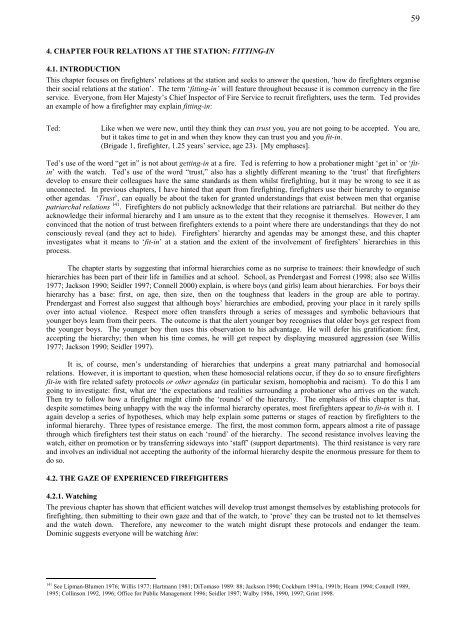One more last working class hero
One more last working class hero
One more last working class hero
You also want an ePaper? Increase the reach of your titles
YUMPU automatically turns print PDFs into web optimized ePapers that Google loves.
59<br />
4. CHAPTER FOUR RELATIONS AT THE STATION: FITTING-IN<br />
4.1. INTRODUCTION<br />
This chapter focuses on firefighters’ relations at the station and seeks to answer the question, ‘how do firefighters organise<br />
their social relations at the station’. The term ‘fitting-in’ will feature throughout because it is common currency in the fire<br />
service. Everyone, from Her Majesty’s Chief Inspector of Fire Service to recruit firefighters, uses the term. Ted provides<br />
an example of how a firefighter may explain fitting-in:<br />
Ted:<br />
Like when we were new, until they think they can trust you, you are not going to be accepted. You are,<br />
but it takes time to get in and when they know they can trust you and you fit-in.<br />
(Brigade 1, firefighter, 1.25 years’ service, age 23). [My emphases].<br />
Ted’s use of the word “get in” is not about getting-in at a fire. Ted is referring to how a probationer might ‘get in’ or ‘fitin’<br />
with the watch. Ted’s use of the word “trust,” also has a slightly different meaning to the ‘trust’ that firefighters<br />
develop to ensure their colleagues have the same standards as them whilst firefighting, but it may be wrong to see it as<br />
unconnected. In previous chapters, I have hinted that apart from firefighting, firefighters use their hierarchy to organise<br />
other agendas. ‘Trust’, can equally be about the taken for granted understandings that exist between men that organise<br />
patriarchal relations 141 . Firefighters do not publicly acknowledge that their relations are patriarchal. But neither do they<br />
acknowledge their informal hierarchy and I am unsure as to the extent that they recognise it themselves. However, I am<br />
convinced that the notion of trust between firefighters extends to a point where there are understandings that they do not<br />
consciously reveal (and they act to hide). Firefighters’ hierarchy and agendas may be amongst these, and this chapter<br />
investigates what it means to ‘fit-in’ at a station and the extent of the involvement of firefighters’ hierarchies in this<br />
process.<br />
The chapter starts by suggesting that informal hierarchies come as no surprise to trainees: their knowledge of such<br />
hierarchies has been part of their life in families and at school. School, as Prendergast and Forrest (1998; also see Willis<br />
1977; Jackson 1990; Seidler 1997; Connell 2000) explain, is where boys (and girls) learn about hierarchies. For boys their<br />
hierarchy has a base: first, on age, then size, then on the toughness that leaders in the group are able to portray.<br />
Prendergast and Forrest also suggest that although boys’ hierarchies are embodied, proving your place in it rarely spills<br />
over into actual violence. Respect <strong>more</strong> often transfers through a series of messages and symbolic behaviours that<br />
younger boys learn from their peers. The outcome is that the alert younger boy recognises that older boys get respect from<br />
the younger boys. The younger boy then uses this observation to his advantage. He will defer his gratification: first,<br />
accepting the hierarchy; then when his time comes, he will get respect by displaying measured aggression (see Willis<br />
1977; Jackson 1990; Seidler 1997).<br />
It is, of course, men’s understanding of hierarchies that underpins a great many patriarchal and homosocial<br />
relations. However, it is important to question, when these homosocial relations occur, if they do so to ensure firefighters<br />
fit-in with fire related safety protocols or other agendas (in particular sexism, homophobia and racism). To do this I am<br />
going to investigate: first, what are ‘the expectations and realities surrounding a probationer who arrives on the watch.<br />
Then try to follow how a firefighter might climb the ‘rounds’ of the hierarchy. The emphasis of this chapter is that,<br />
despite sometimes being unhappy with the way the informal hierarchy operates, most firefighters appear to fit-in with it. I<br />
again develop a series of hypotheses, which may help explain some patterns or stages of reaction by firefighters to the<br />
informal hierarchy. Three types of resistance emerge. The first, the most common form, appears almost a rite of passage<br />
through which firefighters test their status on each ‘round’ of the hierarchy. The second resistance involves leaving the<br />
watch, either on promotion or by transferring sideways into ‘staff’ (support departments). The third resistance is very rare<br />
and involves an individual not accepting the authority of the informal hierarchy despite the enormous pressure for them to<br />
do so.<br />
4.2. THE GAZE OF EXPERIENCED FIREFIGHTERS<br />
4.2.1. Watching<br />
The previous chapter has shown that efficient watches will develop trust amongst themselves by establishing protocols for<br />
firefighting, then submitting to their own gaze and that of the watch, to ‘prove’ they can be trusted not to let themselves<br />
and the watch down. Therefore, any newcomer to the watch might disrupt these protocols and endanger the team.<br />
Dominic suggests everyone will be watching him:<br />
141 See Lipman-Blumen 1976; Willis 1977; Hartmann 1981; DiTomaso 1989: 88; Jackson 1990; Cockburn 1991a, 1991b; Hearn 1994; Connell 1989,<br />
1995; Collinson 1992, 1996; Office for Public Management 1996; Seidler 1997; Walby 1986, 1990, 1997; Grint 1998.
















